Buried Defect Detection Method for a Blowout Preventer Seal Ring Groove Based on an Ultrasonic Phased Array
Abstract
:1. Introduction
2. Identification Method of Structure Echo and Signal Echo Using Ultrasonic Phased Array
2.1. Finite Difference Model of Acoustic Waves in an Elastic Solid
2.2. Deflection and Focusing of Phased Array
3. Simulation and Experiment of Ultrasonic Phased Array for Seal Ring Groove
3.1. Detecting Objects
3.1.1. Test Specimen
3.1.2. Artificial Defects
3.2. Simulation of Ultrasonic Phased Array
3.3. Ultrasonic Phased Array Test
4. Results Analysis and Discussion
4.1. Analysis of Simulation Results
4.2. Test Result Analysis
5. Conclusions
Author Contributions
Funding
Institutional Review Board Statement
Informed Consent Statement
Data Availability Statement
Conflicts of Interest
References
- Shafiee, M.; Elusakin, T.; Enjema, E. Subsea blowout preventer (BOP): Design, reliability, testing, deployment, and operation and maintenance challenges. J. Loss Prev. Process Ind. 2020, 66, 104170. [Google Scholar] [CrossRef]
- Abd Elaziz, M.; Elsheikh, A.H.; Oliva, D.; Abualigah, L.; Lu, S.; Ewees, A.A. Advanced metaheuristic techniques for mechanical design problems: Review. Arch. Comput. Methods Eng. 2022, 29, 695–716. [Google Scholar] [CrossRef]
- Elsheikh, A.H.; Guo, J.; Huang, Y.; Ji, J.; Lee, K.-M. Temperature field sensing of a thin-wall component during machining: Numerical and experimental investigations. Int. J. Heat Mass Transf. 2018, 126, 935–945. [Google Scholar] [CrossRef]
- Tang, Y.; Liu, Q.Y.; Xie, C.; Chen, S.W. Study on stress distribution of a subsea Ram BOP body based on simulation and experiment. Eng. Fail. Anal. 2015, 50, 39–50. [Google Scholar] [CrossRef]
- Kujanpaa, V.P. Weld defects in austenitic stainless steel sheets-effect of welding parameters. Weld. J. 1983, 62, 45–52. [Google Scholar]
- Cui, Y.; Lundin, C.D. Effect of microfissures on mechanical properties of 308L austenitic stainless steel weld metals. J. Mater. Sci. 2005, 40, 1281–1283. [Google Scholar] [CrossRef]
- Mohamad, G.D.; Nadimul, H.F.; Fraser, O.; John, A.S.; Mohamed, E.S. Acoustic emission method for defect detection and identification in carbon steel welded joints. J. Constr. Steel Res. 2017, 134, 28–37. [Google Scholar]
- Zolfaghari, A.; Zolfaghari, A.; Kolahan, F. Reliability and sensitivity of magnetic particle nondestructive testing in detecting the surface cracks of welded components. Nondestruct. Test. Eval. 2018, 33, 290–300. [Google Scholar] [CrossRef]
- Chauveau, D. Review of NDT and process monitoring techniques usable to produce high-quality parts by welding or additive manufacturing. Weld. World 2018, 62, 1097–1118. [Google Scholar] [CrossRef]
- Xie, F.Q.; Wu, X.H.; Zhang, H.Y.; Zhang, X. Research on pulsed eddy current automatic detection technology for weld defects of pressure vessel cylinder. Measurement 2021, 176, 109981. [Google Scholar] [CrossRef]
- Jiang, H.Q.; Liang, Z.M.; Gao, J.M.; Dang, C.Y. Classification of weld defect based on information fusion technology for radiographic testing system. Rev. Sci. Instrum. 2016, 87, 035110. [Google Scholar] [CrossRef] [PubMed]
- Cheng, Y.H.; Bai, L.B.; Yang, F.; Chen, Y.F.; Jiang, S.H.; Chun, Y. Stainless steel weld defect detection using pulsed inductive thermography. IEEE Trans. Appl. Supercond. 2016, 26, 0606504. [Google Scholar] [CrossRef]
- Zhuo, R.J.; Deng, Z.H.; Chen, B.; Liu, G.Y.; Bi, S.H. Overview on development of acoustic emission monitoring technology in sawing. Int. J. Adv. Manuf. Technol. 2021, 116, 1411–1427. [Google Scholar] [CrossRef]
- Ye, J.H.; Ni, R.H.; Hsu, Q.C. Image feature analysis for magnetic particle inspection of forging defects. Proc. Inst. Mech. Eng. Part B J. Eng. Manuf. 2021, 09544054211014443. [Google Scholar] [CrossRef]
- Lu, Q.Y.; Wong, C.H. Applications of non-destructive testing techniques for post-process control of additively manufactured part. Virtual Phys. Prototyp. 2017, 12, 301–321. [Google Scholar] [CrossRef]
- Xie, Y.D.; Li, J.Y.; Tao, Y.; Wang, S.P.; Yin, W.L.; Xu, L.J. Edge effect analysis and edge defect detection of titanium alloy based on eddy current testing. Appl. Sci. 2020, 10, 8796. [Google Scholar] [CrossRef]
- Boaretto, N.; Centeno, T.M. Automated detection of welding defects in pipelines from radiographic images DWDI. NDT E Int. 2017, 86, 7–13. [Google Scholar] [CrossRef]
- Zhu, J.Z.; Min, Q.X.; Wu, J.B.; Tian, G.Y. Probability of detection for eddy current pulsed thermography of angular defect quantification. IEEE Trans. Ind. Inform. 2018, 14, 5658–5666. [Google Scholar] [CrossRef]
- Moles, M.; Dube, N.; Labbe, S.; Ginzel, E. Review of ultrasonic phased arrays for pressure vessel and pipeline weld inspections. J. Press. Vessel Technol. 2005, 127, 351–356. [Google Scholar] [CrossRef]
- Xu, Q.; Wang, H. Sound field modeling method and key imaging technology of an ultrasonic phased array: A review. Appl. Sci. 2022, 12, 7962. [Google Scholar] [CrossRef]
- Wu, Y.; Pei, C.; Zhang, H.; Liu, Y.; Jia, P. A fast finite element simulation method of phased array ultrasonic testing and its application in sleeve fillet weld inspection. Appl. Sci. 2022, 12, 5384. [Google Scholar] [CrossRef]
- Feng, L.Y.; Qian, X.D. Enhanced sizing for surface cracks in welded tubular joints using ultrasonic phased array and image processing. NDT E Int. 2020, 116, 102334. [Google Scholar] [CrossRef]
- Lopez, A.B.; Santos, J.; Sousa, J.P.; Santos, T.G.; Quintino, L. Phased array ultrasonic inspection of metal additive manufacturing parts. J. Nondestruct. Eval. 2019, 38, 62–72. [Google Scholar] [CrossRef]
- Ma, M.Y.; Cao, H.Y.; Jiang, M.S.; Sun, L.; Zhang, L.; Zhang, F.Y.; Sui, Q.M.; Tian, A.Q.; Liang, J.Y.; Jia, L. High precision detection method for delamination defects in carbon fiber composite laminates based on ultrasonic technique and signal correlation algorithm. Materials 2020, 13, 3840. [Google Scholar] [CrossRef]
- Li, W.T.; Zhou, Z.G.; Li, Y. Inspection of butt welds for complex surface parts using ultrasonic phased array. Ultrasonics 2019, 96, 75–82. [Google Scholar] [CrossRef]
- Wang, X.H.; Li, W.T.; Li, Y.; Zhou, Z.G.; Zhang, J.J.; Zhu, F.J.; Miao, Z. Phased array ultrasonic testing of micro-flaws in additive manufactured titanium block. Mater. Res. Express 2020, 7, 016572. [Google Scholar] [CrossRef]
- Chabot, A.; Laroche, N.; Carcreff, E.; Rauch, M.; Hascoet, J.Y. Towards defect monitoring for metallic additive manufacturing components using phased array ultrasonic testing. J. Intell. Manuf. 2020, 31, 1191–1201. [Google Scholar] [CrossRef]
- Li, D.B. Equations and Computational Methods for Computational Acoustics—Acoustic Field; Science Press: Beijing, China, 2003. [Google Scholar]
- Azar, L.; Shi, Y.; Wooh, S.C. Beam focusing behavior of linear phased arrays. NDT E Int. 2000, 33, 189–198. [Google Scholar] [CrossRef]
- Calmon, P.; Mahaut, S.; Chatillon, S.; Raillon, R. CIVA: An expertise platform for simulation and processing NDT data. Ultrasonics 2006, 44, e975–e979. [Google Scholar] [CrossRef]
- Kim, G.; Seo, M.K.; Kim, Y.I.; Kwon, S. Development of phased array ultrasonic system for detecting rail cracks. Sens. Actuators A Phys. 2020, 37, 112086. [Google Scholar] [CrossRef]
- Long, R.; Russell, J.; Cawley, P. Ultrasonic phased array inspection using full matrix capture. Insight Non Destr. Test. Cond. Monit. 2012, 54, 380–385. [Google Scholar] [CrossRef]

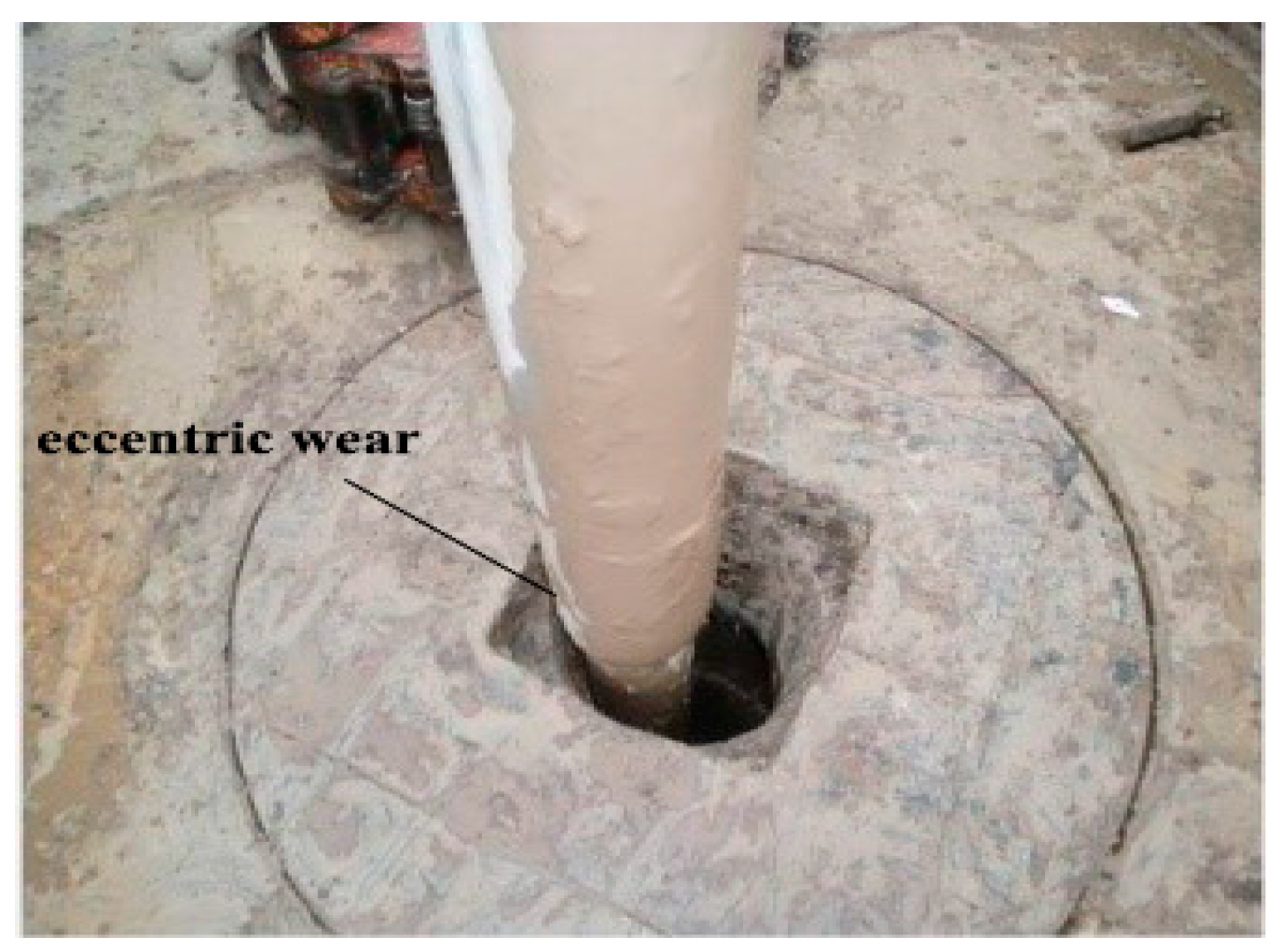
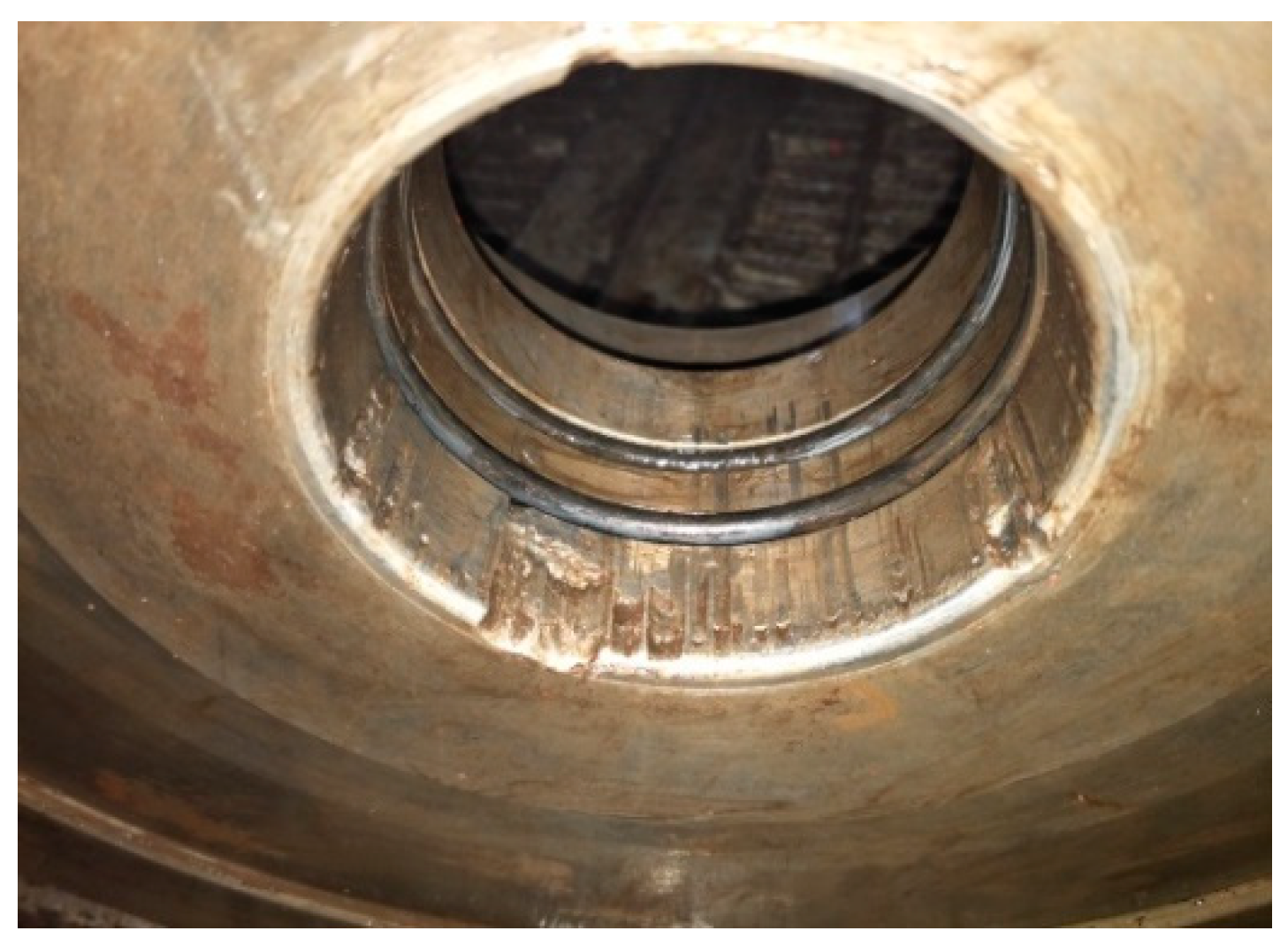

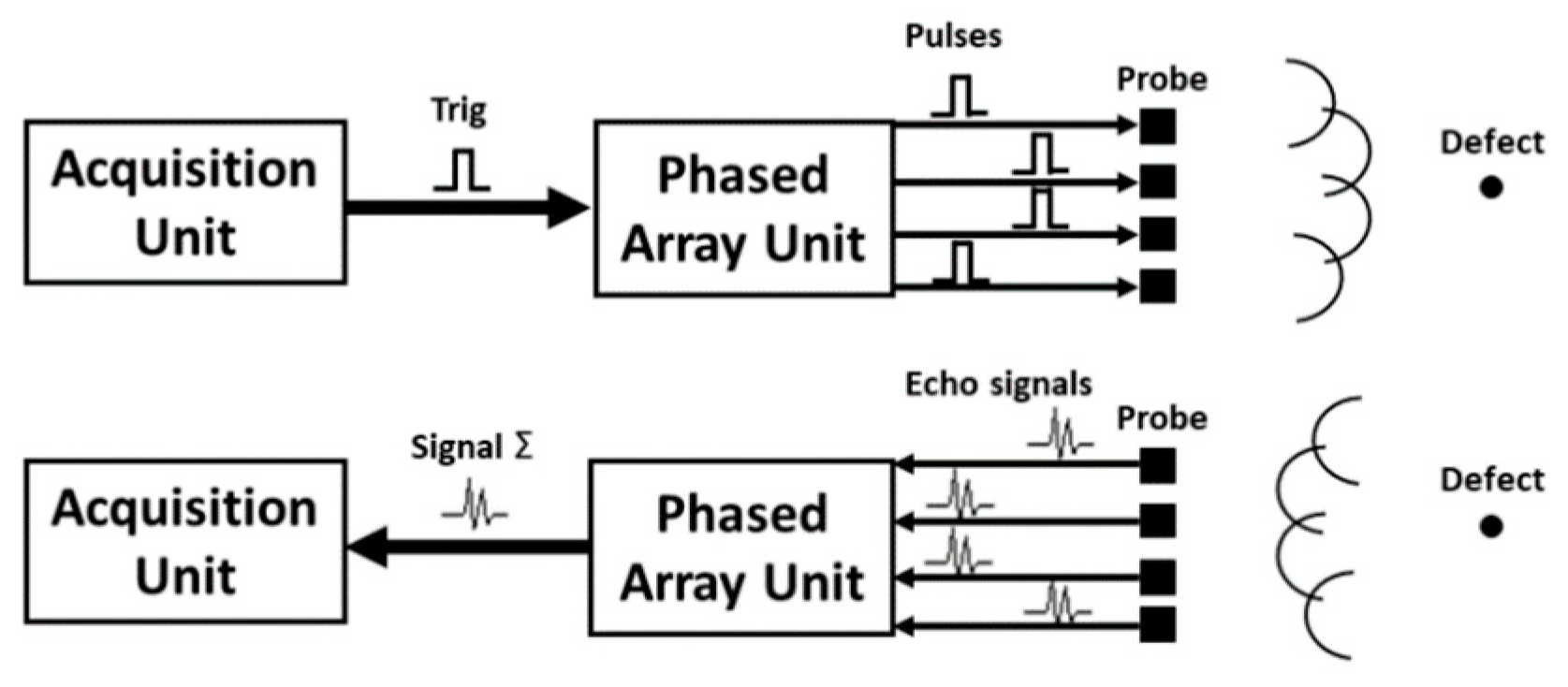
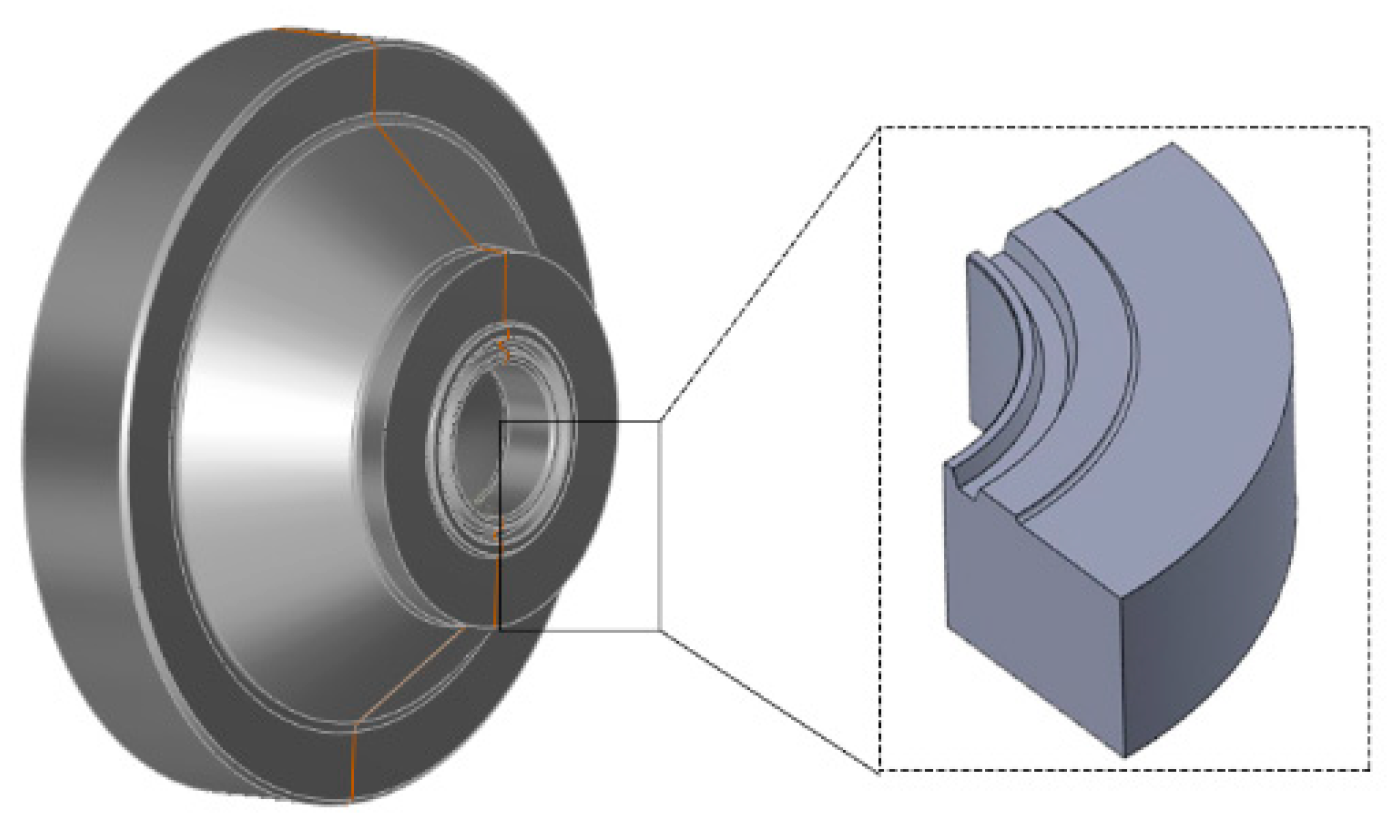
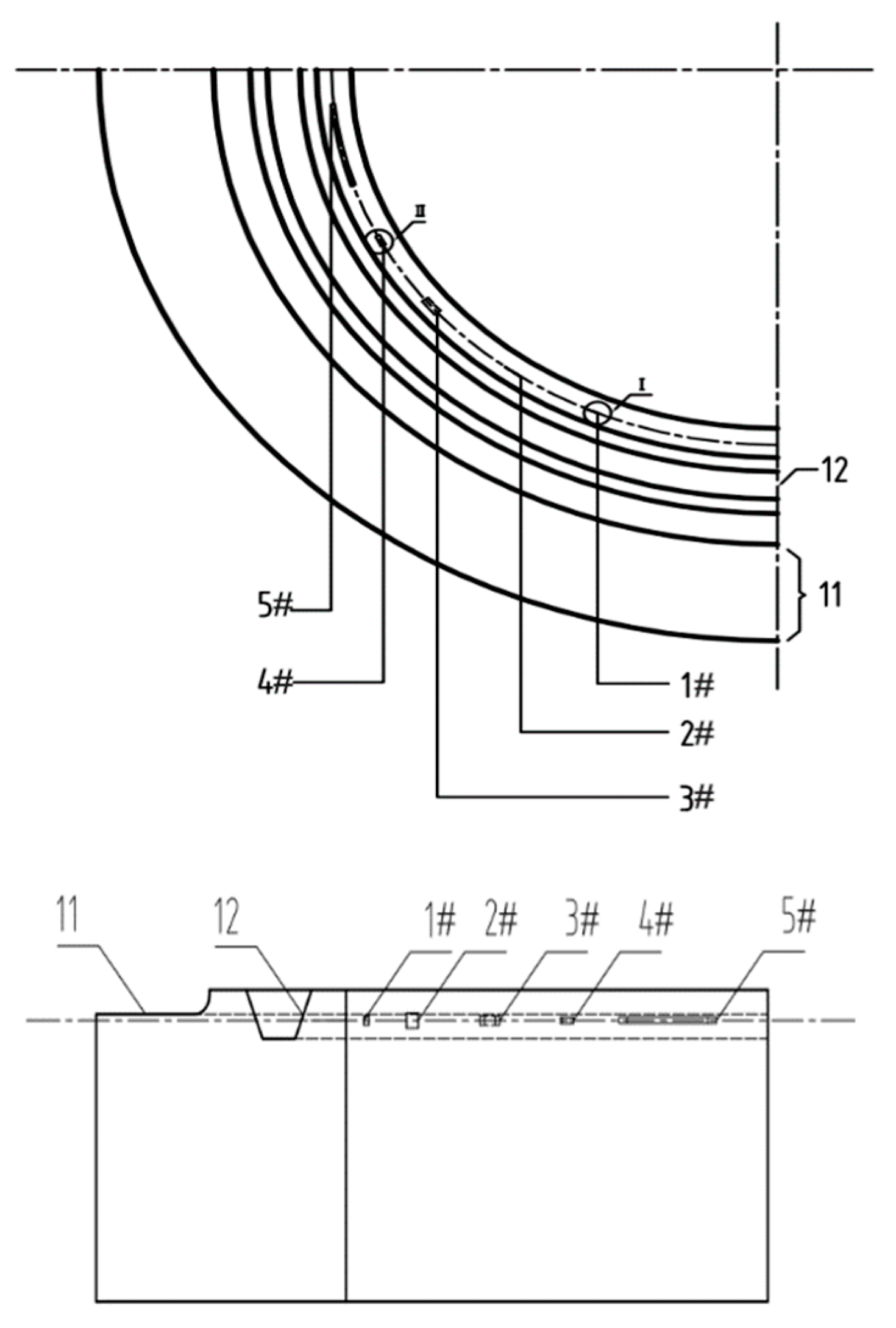

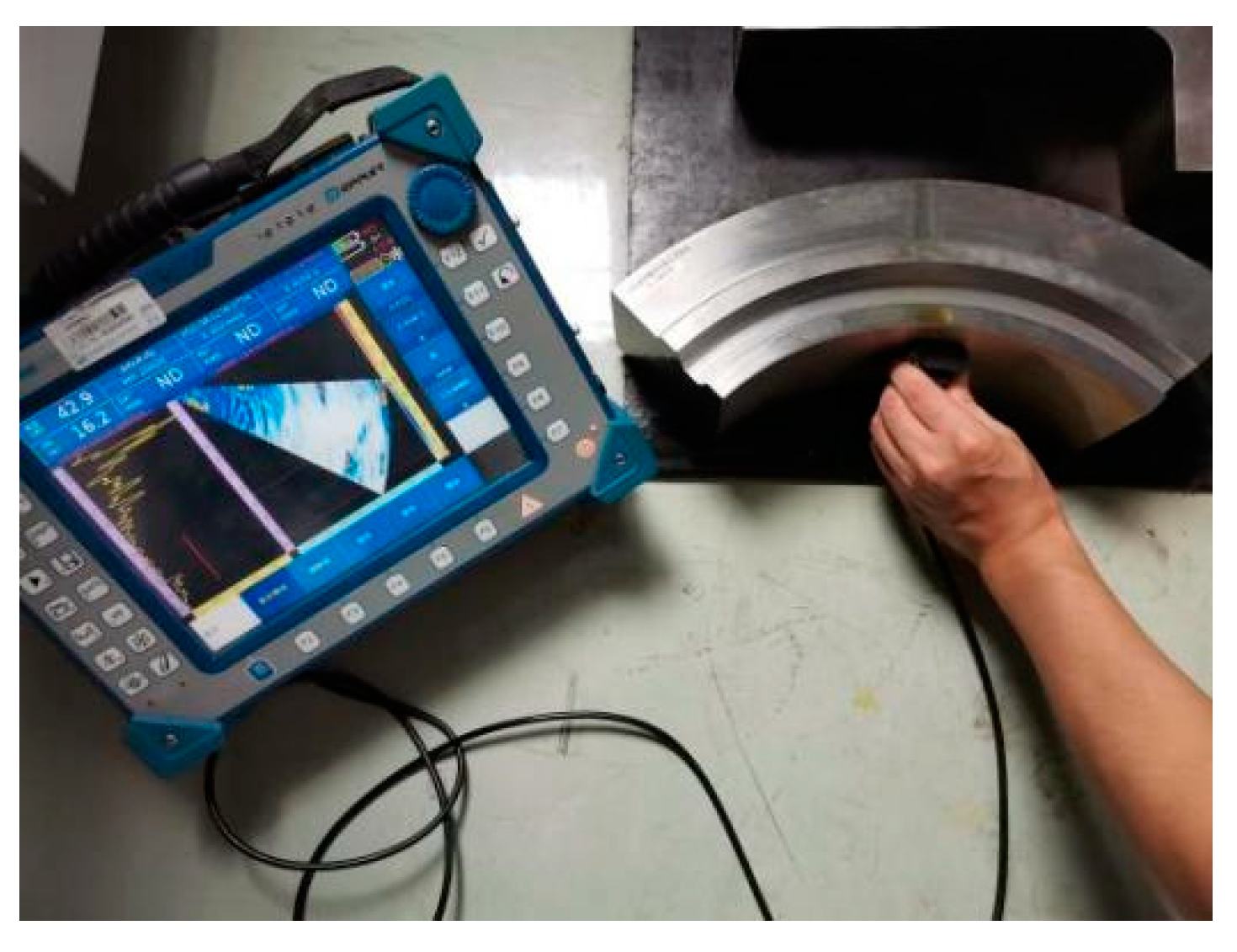
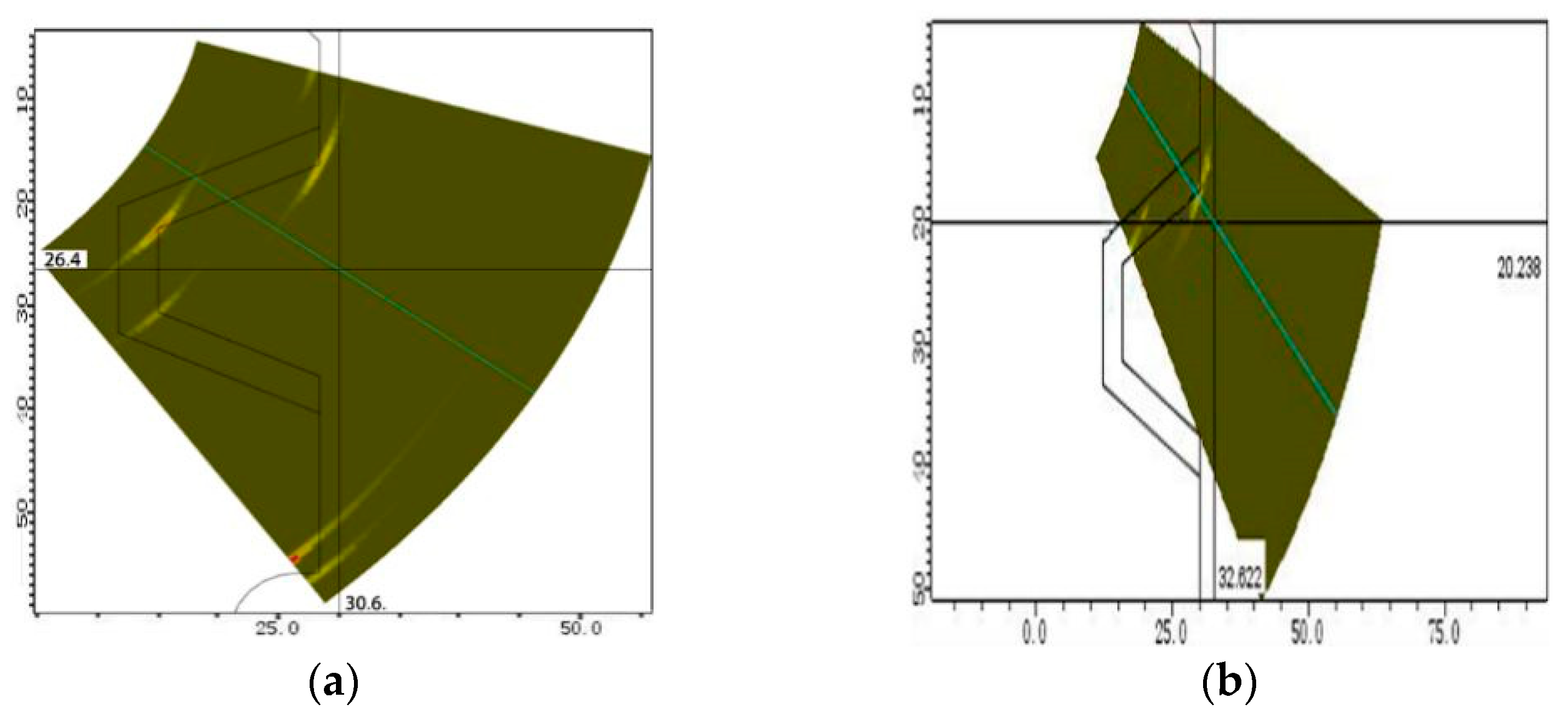
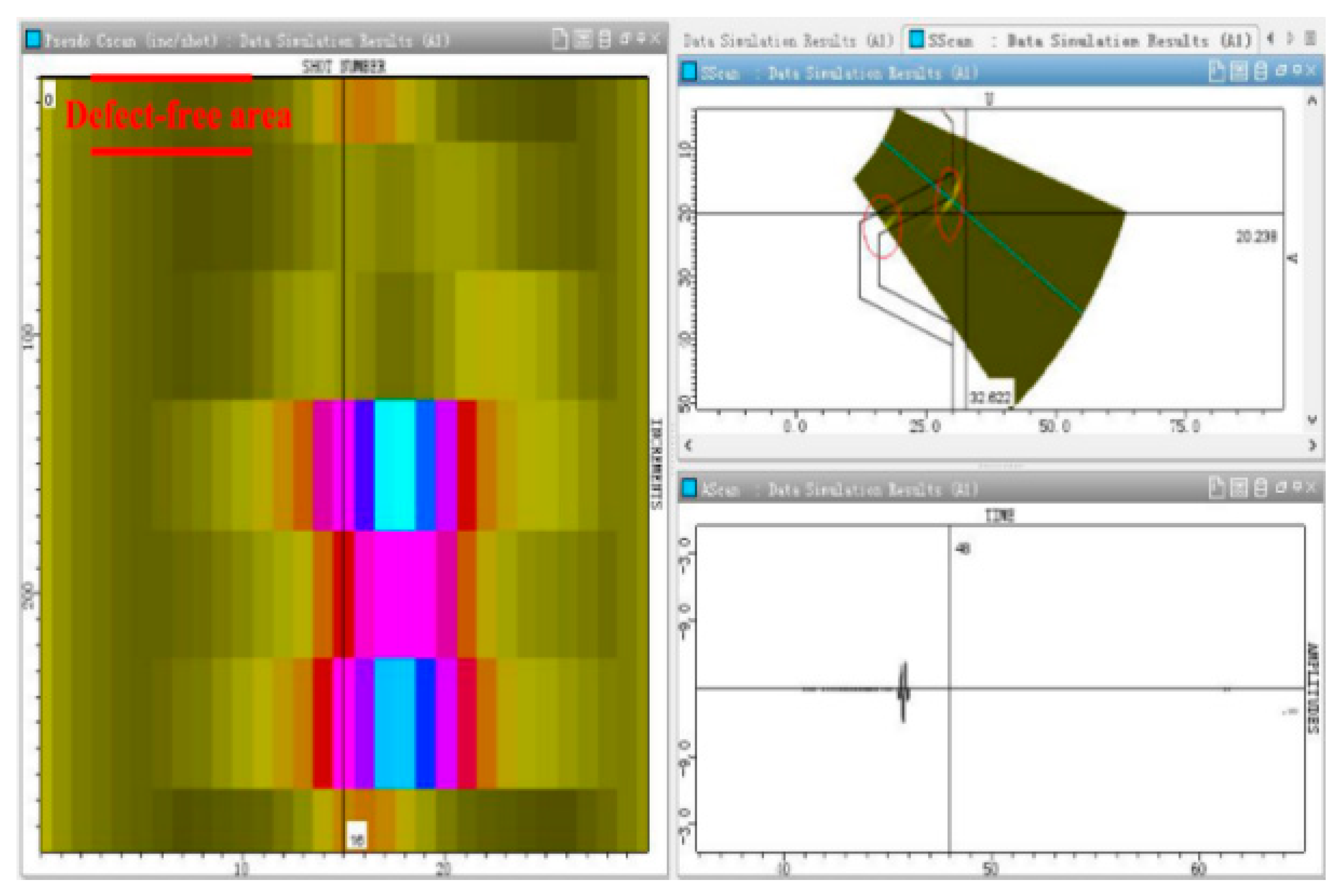
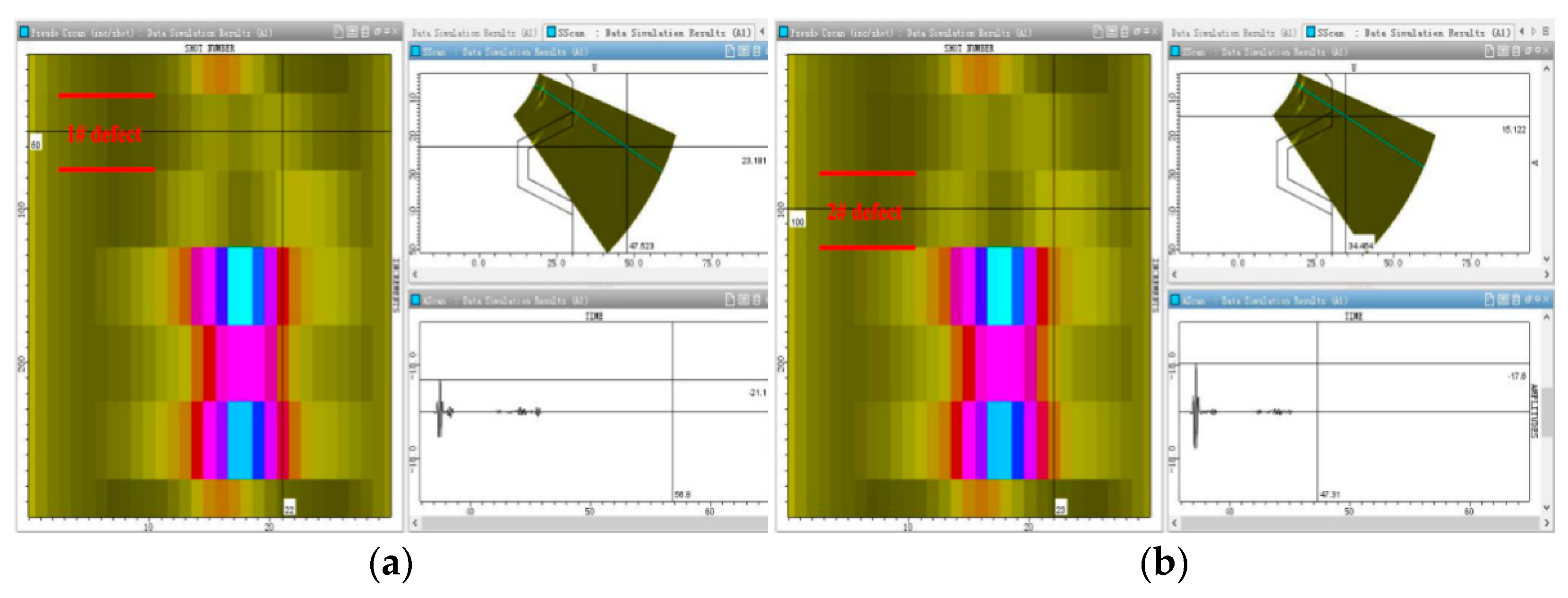
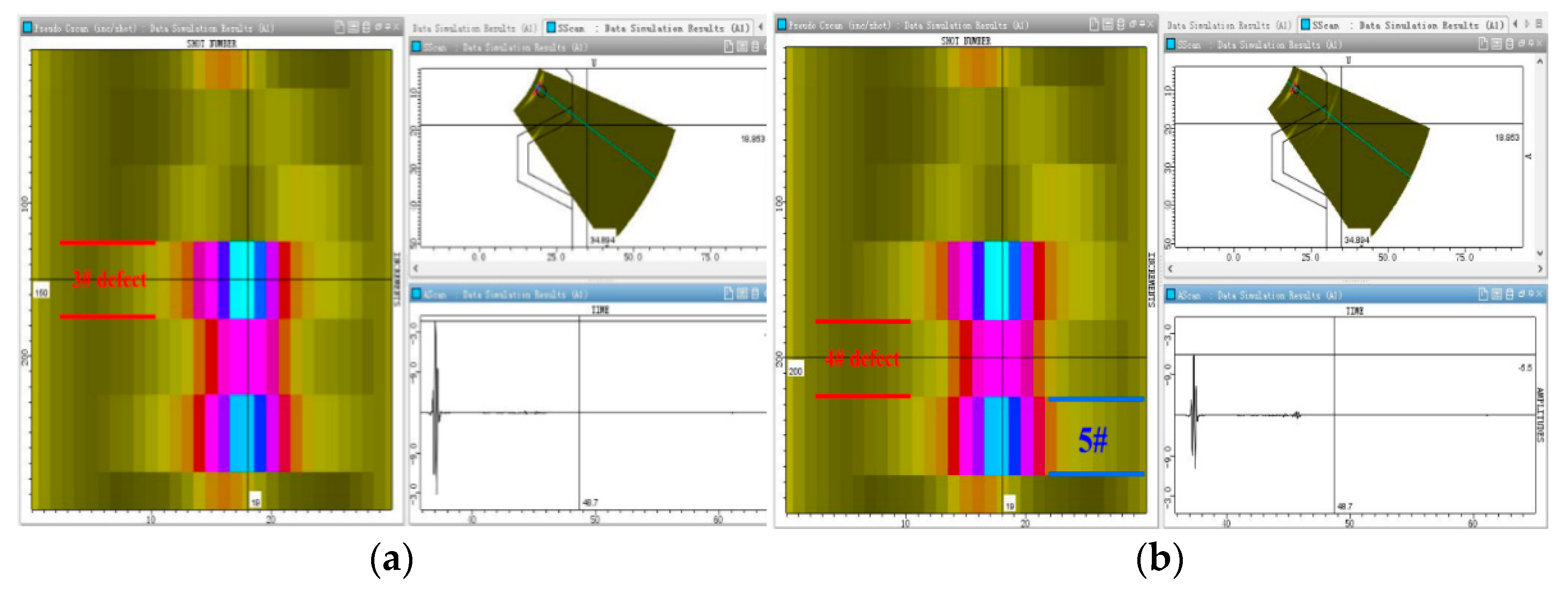
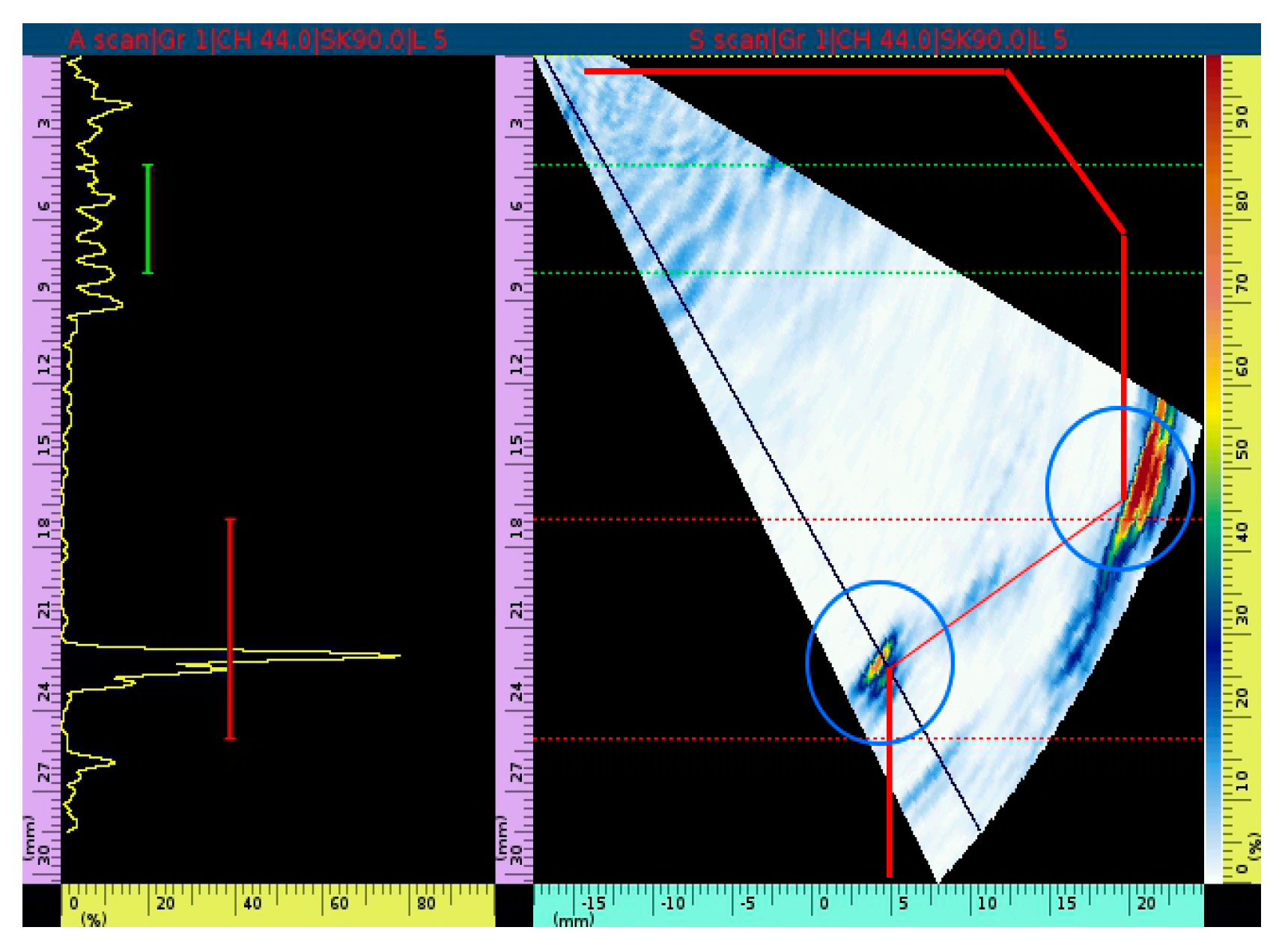




| Defect Number | Defect Type | Section Size/mm | Length/mm | Simulated Defect Type |
|---|---|---|---|---|
| 1# | Groove | 3 | 5 | Simulated crack |
| 2# | Groove | 5 | 8 | Simulated crack |
| 3# | Horizontal hole | Ø 3 | 8 | Simulated slag inclusion |
| 4# | Horizontal hole | Ø 2 | 5 | Simulated pore |
| 5# | Horizontal hole | Ø 2 | 40 | Calibration |
| Defect Number | Defect Size/mm | Amplitude/dB | Reference Amplitude/dB (2 × 40 Transverse Hole) | Relative Amplitude (Absolute Value)/dB |
|---|---|---|---|---|
| 1# | 5 × 3 | −21.1 | −2.1 | 19 |
| 2# | 8 × 5 | −17.6 | −2.1 | 15.5 |
| 3# | 8 × Ø 3 | −1.8 | −2.1 | 0.3 |
| 4# | 5 × Ø 2 | −5.5 | −2.1 | −3.4 |
| Defect Number | Defect Size/mm | Amplitude/dB | Reference Amplitude/dB (2 × 40 Transverse Hole) | Relative Amplitude (Absolute Value)/dB | Error/dB |
|---|---|---|---|---|---|
| 1# | 5 × 3 | −46.9 | −27.5 | 19.4 | 0.4 |
| 2# | 8 × 5 | −42.1 | −27.5 | 14.6 | 0.9 |
| 3# | 8 × Ø 3 | −26.7 | −27.5 | 0.8 | 0.5 |
| 4# | 5 × Ø 2 | −31.1 | −27.5 | 3.6 | 0.2 |
Publisher’s Note: MDPI stays neutral with regard to jurisdictional claims in published maps and institutional affiliations. |
© 2022 by the authors. Licensee MDPI, Basel, Switzerland. This article is an open access article distributed under the terms and conditions of the Creative Commons Attribution (CC BY) license (https://creativecommons.org/licenses/by/4.0/).
Share and Cite
Wang, S.; Zhang, L.; Yu, P.; Xu, Q.; Fan, J.; Yu, J. Buried Defect Detection Method for a Blowout Preventer Seal Ring Groove Based on an Ultrasonic Phased Array. Materials 2022, 15, 6429. https://doi.org/10.3390/ma15186429
Wang S, Zhang L, Yu P, Xu Q, Fan J, Yu J. Buried Defect Detection Method for a Blowout Preventer Seal Ring Groove Based on an Ultrasonic Phased Array. Materials. 2022; 15(18):6429. https://doi.org/10.3390/ma15186429
Chicago/Turabian StyleWang, Shiqiang, Laibin Zhang, Peihang Yu, Qiang Xu, Jianchun Fan, and Jiamin Yu. 2022. "Buried Defect Detection Method for a Blowout Preventer Seal Ring Groove Based on an Ultrasonic Phased Array" Materials 15, no. 18: 6429. https://doi.org/10.3390/ma15186429
APA StyleWang, S., Zhang, L., Yu, P., Xu, Q., Fan, J., & Yu, J. (2022). Buried Defect Detection Method for a Blowout Preventer Seal Ring Groove Based on an Ultrasonic Phased Array. Materials, 15(18), 6429. https://doi.org/10.3390/ma15186429




